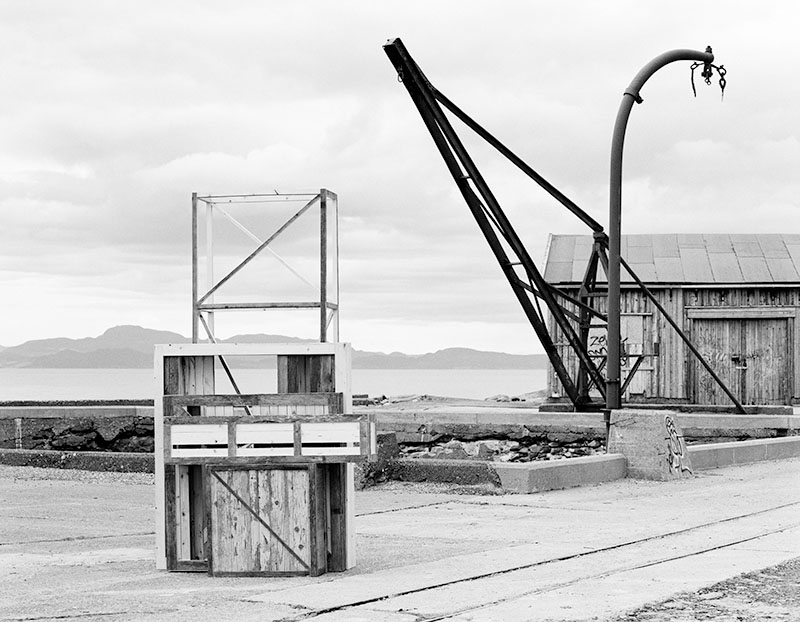FOR ENGLISH TEXT PLEASE SCROLL DOWN, THANKS.
Planer i endring
Silbergelatine-prints auf Baryt, Maße variabel
2015
Stark verkürzt gesagt war bei diesem Unterfangen das Unterwegssein – die Erkundung peripherer Orte zu Fuß und per Fahrrad Auslöser eines Denkprozesses, der zu einer Planänderung innerhalb eines künstlerischen Prozesses führte. Letztlich kam es dabei auch zu einem Transfer von gefundenem Material vom Außenraum in den Atelierraum, wo dieses zu mehreren dreidimensionalen Objekten weiterverarbeitet wurde. Als weiteren Zwischenschritt fanden diese ihren Weg in den Kunstraum und wurden im Rahmen einer Ausstellung gezeigt, um in weiterer Folge an einem dafür ausgewählten Ort sich selbst überlassen zu werden. Was blieb war die fotografische Dokumentation.
In der Vorgangsweise spielt einerseits das Lokale (vor Ort aufzufindendes Material und dessen Besonderheiten), als auch das Globale (der Blick auf das System Kunst und seine Bedingtheiten) sowie die Beobachtung des eigenen künstlerischen Prozesses eine wesentliche Rolle.
– – – – – – – – – – – – – – – – – – – – – – – – – – – – – – – – – –
Led Astray – Notes on Stefan Klampfer’s exhibition »Planer i endring« at Babel Visningsrom for Kunst By Inger Marie Hahn Møller, M A in art history
When we enter the white cube of an exhibition space we only experience a tiny part of what happened. What we see seems definitive. What we normally don’t see is the process, the dead ends, the failures and the changes in plans that the artist might have struggled. In his exhibition Planer i endring Austrian Stefan Klampfer makes a topsy-turvy on the concept of the art exhibition. Instead of presenting a determined set of truths his work is exposing the vulnerable aspects of the artistic process in an open dialog that rather becomes a set of meta-reflections on the exhibition practice in itself.
As his starting point Klampfer chooses one of art history’s biggest failures and successes, August Rodin’s Monument to Balzac from 1898. Rodin was commissioned to make the monument and disappeared into 6 years of study and work. What started out as a portrait of a nude body ended up as an elimination of body, physicality and form in favour of a strong depiction of the writer’s psychological persona. The body of the writer is wrapped up in a dressing gown that symbolically blurs the body into a pure focus on his mind or spirit. The sculpture was a scandal in its time but has later been considered the first truly modern sculpture. What interests Klampfer is exactly this elimination of body and form – and especially he is drawn towards some of Rodin’s studies where the dressing gown literally stands as an empty shell – an empty sculpture open toward interpretation and signification.
During his process Klampfer is led astray. He is lost in a wilderness of dead ends and closed off doors. Just as you might say Rodin was during his 6 years of working with the problematics of a body and a dressing gown. In the end, Klampfer appropriates the same artistic approach as Rodin. Just as Rodin eliminates the body of his subject in order to create a portrait of the personality and mind of Balzac, you could say that Klampfer is eliminating the “body” of the classic exhibition with his own set of “empty sculptures”. Instead of an exhibition presenting the body or the materiality of sculpture, he aims at pointing out a number of considerations on the genealogy of the exhibition per se.
He lays bare his doubts, his questions, his failures – what is normally hidden underneath the smooth surface of the finished piece of art. A s a mark of his failures he builds a series of empty crates or sculpture boxes out of discarded found wood. They are glued together, fragile and easily falling apart as a visualisation of his own process and of the construction of art. This emblematic emptiness points towards the emptiness of the art institution and the concept of the exhibition space as a white cube. But in a more productive field the emptiness of the sculptures indicates an openness towards the spectator, a gab for dialogue and new insight.
Planer i endring – or “change of plans” is on a pragmatic level exactly what happened for Klampfer as for many other artists during the history of art. What started out as a planned exhibition of Balzac’s empty dressing gown ended up as a meta-exhibition exposing subtle considerations on what art and exhibition is at all, and showing how art has a potential as being exactly a construction. Just like Rodin spent 6 years with physical processes exploring his subject, Klampfer has gone through a number of material experiments – building empty crates, observing his physical surroundings, documenting every sealed off door he meets and registering the traces of the glue his is using – in order to end up with his conceptual meta-reflections. Planer i endring is a conglomerate letting the emptiness, the negations, the rejections and the changes in direction and plans being the content in itself. Being led astray might also be productive.





















